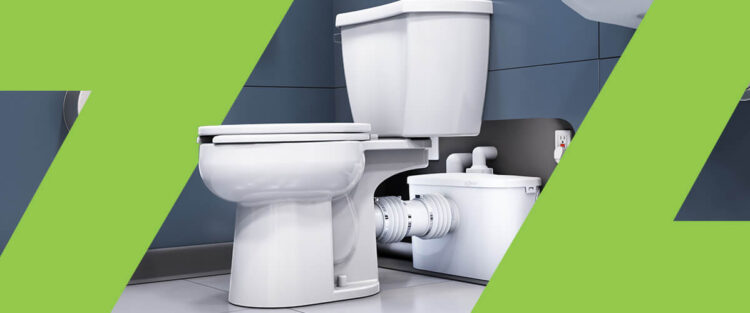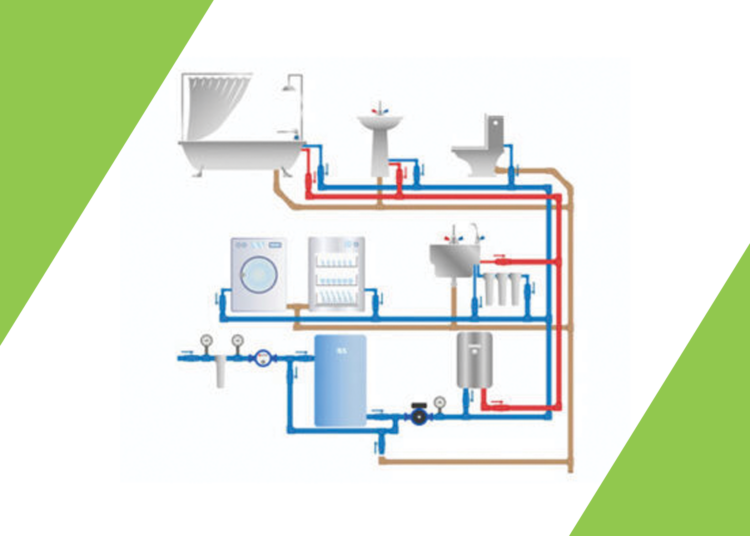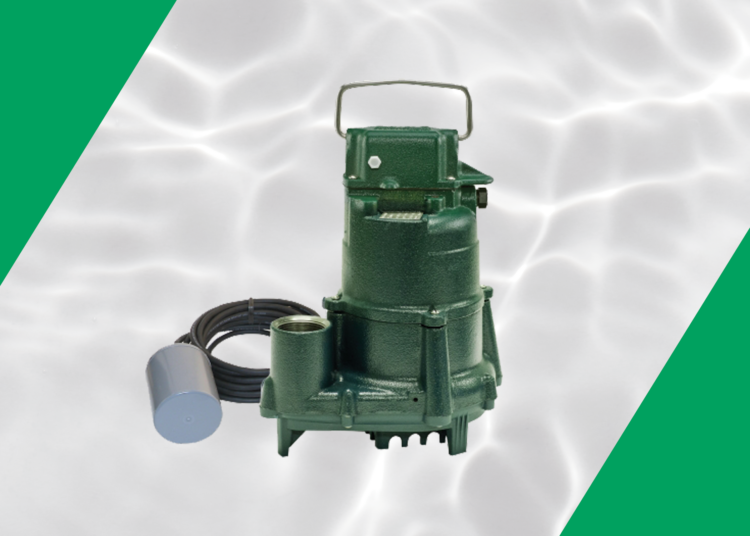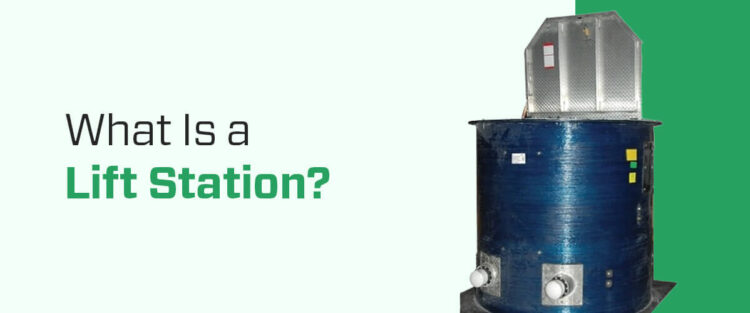
A lift station is an important part of the wastewater treatment process. Lift stations support sewer gravity pipelines by moving water from lower to higher elevations. These pressurized systems push wastewater to water treatment facilities so it can be safely treated and returned to a natural source.
Wastewater lift stations are important because they reduce sewer system installation costs and help to protect human health and safety. Continue reading to learn more about lift stations and how they support the wastewater treatment process.
What Is a Lift Station?
A lift station is a system that pumps wastewater from a lower elevation to a higher elevation. Wastewater from a lower elevation cannot flow to wastewater treatment plants via gravity because the treatment plants are too far away from some properties. Wastewater lift stations exist at certain points along sewage gravity pipeline systems to collect wastewater at central points and help move it to treatment plants.
A lift station pump system sucks water from a gravity pipeline system and pressurizes it before pumping it along to a treatment center. Lift stations can consist of the following components:
- Pumps and compressors
- Associated valves
- Receiving well
- Screen for solid material removal
- Electric motors
- Power supply system
- Ventilation and odor control system
- Lift station alarm and equipment control system
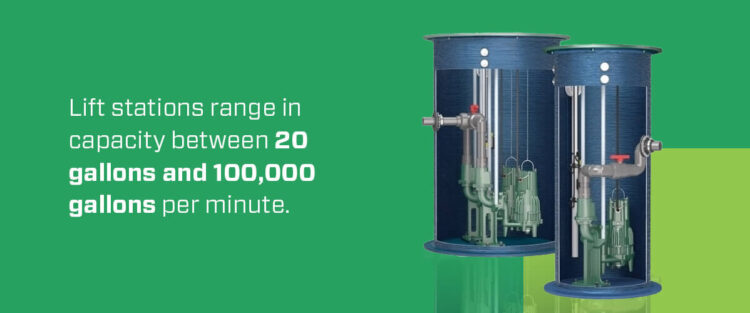
Many lift stations also have equipment that facilitates easy pump removal for maintenance purposes. This equipment can include pump room openings or floor access hatches, bridge cranes, overhead monorail beams, and portable hoists. Some lift stations are pre-fabricated, while others can be customized and constructed on-site. Lift stations range in capacity between 20 gallons and 100,000 gallons per minute.
How Do Lift Stations Work?
Sewage collection systems are made up of gravity pipelines, which are underground sloped pipelines that use gravity to move wastewater. When wastewater flows into the pipes from a lower elevation, gravity cannot force it upwards to a wastewater treatment plant because this would defy the laws of physics. In these situations, wastewater lift stations collect water from gravity pipelines and push it to a higher elevation. Lift stations operate automatically and do not typically require constant on-site monitoring.
A storage container known as a dry or wet well collects raw sewage from gravity pipelines. The well holds wastewater for testing and monitoring and removes solid materials from the water. When wastewater reaches a predetermined level inside the well, a lift station pump uses a pressurized sewer force main to lift the water from the well and pressurize it so it can travel upwards. The sewer force can consist of pumps and compressors that give water the boost it needs to travel to the wastewater treatment plant.
Are There Different Types of Lift Stations?
Lift stations can operate using a dry well or a wet well. Traditional lift stations use dry wells, which are located in a separate chamber or underground. Submersible pumps, also known as wet wells, are more modern, and they are submerged underwater in the wastewater that they pump. Submersible pumps are mounted inside wet wells and pump wastewater using a motor.
What Are the Benefits of Lift Stations?
Lift stations are beneficial because they move wastewater to treatment facilities when gravity is not enough. Wastewater is a hazardous material, so it’s important to have an effective system in place for its safe removal and treatment.
Lift stations reduce the cost of sewer system installation. If gravity sewer line trenches are deeper than 10 feet, construction costs increase significantly because installation requires more complex equipment. Additionally, gravity sewer line sizes depend on the minimum pipe slope. Since pumping water can achieve the same flow with shallower depths and smaller pipeline sizes, it reduces pipeline installation costs.
How to Ensure You Have an Effective Lift Station
The most effective lift stations meet certain standards. To ensure you choose a lift station that will meet your client’s needs, make sure it can accomplish the following:
- Reliable operation with no interruptions
- A pump capacity that matches the quality and amount of wastewater being treated
- Zero restrictions to future expansion and capacity needs
- Streamlined operation and maintenance
- Ability to prevent excessive odor release
- Minimal environmental impact on surrounding areas
- Overflow and flood prevention
Lift stations operate on electricity, and they should have a reliable backup power supply in the event of a power outage. Lift station pumps determine lift station system performance. A lift station’s main performance characteristics consist of the following:
- Head: A lift station’s head is the amount of energy the system supplies to the wastewater per unit weight.
- Capacity: A system’s capacity is also known as its flow rate, and it’s the quantity of liquid a system can pump in a certain amount of time. You can measure capacity in gallons per minute or million gallons per day.
- Power: Power is the amount of energy a pump consumes per unit of time. In most cases, this is measured in kilowatt-hours.
- Efficiency: A lift station’s efficiency is its ratio of applied power to its useful hydraulic work output.
Ordering a custom-made lift station package can help you ensure your lift station operates with top performance. When you customize a lift station to meet your needs, you can achieve the highest effectiveness and efficiency possible.
Lift Station Maintenance Requirements
Wastewater lift station operators must properly maintain lift stations for health and safety purposes because sewage is a hazardous substance. Operators are legally required to perform routine maintenance and maintain a maintenance record. A lift station operator must perform the following (but not limited to) maintenance tasks:
- Monitor and log flow readings
- Grease motors
- Clean floats
- Test power supplies and lift station alarms
- Test backup generators
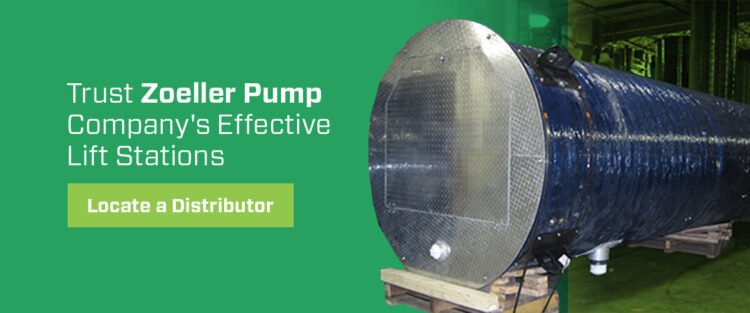
Trust Zoeller Pump Company’s Effective Lift Stations
Lift stations are important because they effectively move wastewater upwards when gravity is not enough. These crucial systems make it possible for wastewater to reach treatment facilities where it is treated for health and safety purposes. They also reduce sewer system costs because they do not require deep trenches or complex installation.
Zoeller Pump Company offers effective lift station options to meet each of your clients’ needs. The Qwik Lift Station pump package is a prefabricated lift Station system with Z-Rail® technology. The Qwik Lift package system is factory-assembled for quick and easy installation. Constructed with durable components, the Qwik Lift system is long-lasting, stable, and reliable. Zoeller Pump Company offers various basin depths and diameters to accommodate different projects, and you can choose between steel or aluminum hatches.
If you need lift stations that are more tailored to your jobs, Zoeller Pump Company also offers custom-made lift station packages. Custom-made packages are designed and assembled to meet all of your client’s needs, so you can provide efficient solutions and become a trusted contractor in your field. Locate your nearest distributor to purchase effective lift stations from Zoeller Pump Company.


